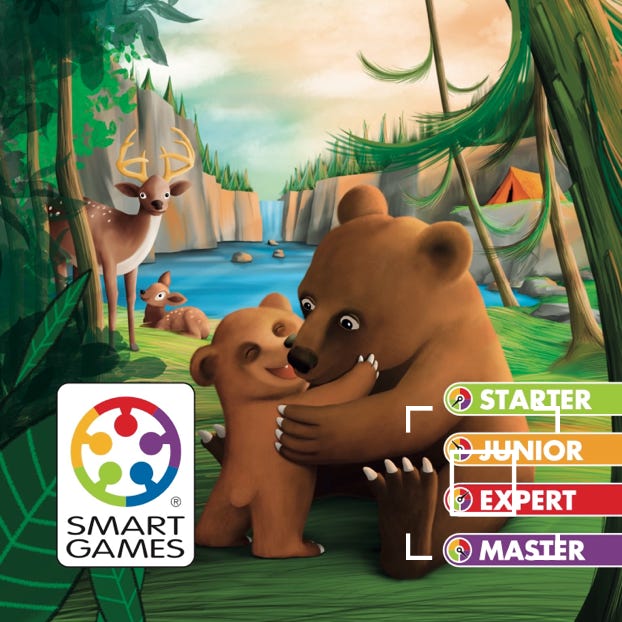
Grizzly Gears
The product development of Grizzly Gears (for SmartGames)
Raf Peeters, January 2022
In 2021 I wanted to make a sequential movement puzzle based on Vikings, a game I designed in 2012. That game is probably one of the most original games I ever made, but it didn’t sell very good, so Smart stopped producing it a long time ago. Although Grizzly Gears uses a similar game mechanics, it’s much more than just an updated version with a different theme.
GOING AROUND IN CIRCLES
The original Viking game had very nice challenges, but also a few design flaws. So there was enough room for improvement when I started with this project:
1) The packaging was a real (unintended) packing problem, because we used a blister to show the ships through the window. This problem was easily solved, because since our new line look, most of our boxes don’t use a blister or window any more but an image of the product.
2) In Vikings a lot of setup was required when you started with a new challenge. You needed to place the 9 rotating disks on the game board, the ships, but also the end positions. This was done by clicking colored clips on the border of the game board. In Grizzly Gears this last part of the setup is no longer needed. There are now 6 fixed end positions on the left and right border of the game board. Instead of 4 boats, there are now 6 possible “loose” figurines. Each figurine has a specific goal which is always the same for that figurine, so you don’t have to explain that. To have different end position you just change which figurines you use (instead of changing the position of the clips). To further reduce the setup work, the position of the 9 rotating disks doesn’t change for the 4 challenges that are printed on the same page. Of course you still have to rotate them in the right orientation when you start a new challenge!
3) However, the biggest difference between Vikings and Grizzly Gears is the game play. In Vikings you were only allowed to rotate the disks using the ships as a key. Therefor, all other disks without ships could not be rotated. This resulted in nice challenges with many steps, but was confusing for some players, who rotated empty disks anyway. Instead of enforcing this game rule (I would not know how to do that), I just allowed the opposite. In Grizzly Gears you can rotate any disk, with or without a figurine. And to make that movement simpler, there is a pine tree in the centre of each disk. By manipulating trees, figurines move through the forest, which is kind of cool IMHO. Removing this game rule, also makes the game easier to solve. I never found Vikings a difficult game, but most consumers apparently did. So, the fact that Grizzly Gears is slightly easier is rather an advantage. But the difference in difficulty is smaller than you might think. The longest solution in Vikings was 30 steps, compared to 28 steps in Grizzly Gears. To put that in perspective, any challenge from Rubricks’ Cube can be solved in 20 steps or less. The hardest challenge in Asteroid Escape is more than 100 steps and theoretically the hardest one in Temple Trap could be almost 200 steps. If I say 28 steps, it means that a computer can solve it in 28 steps, but we humans normally need a lot more , because we can only focus on the movement of one figurine at the same time.
4) When I designed Vikings, most SmartGames had 48 or 60 challenges. But since 2016 we try to give games of this size (Classic square boxes) 80 challenges. This has the benefit that the difficulty is going up more slowly and that there are therefor more challenges in each level. BTW, this game doesn’t include the Wizard level, because it never becomes difficult enough to justify such a level. I only include a Wizard level if nobody of the (normal) people who play test a game, can solve the challenges in less than 10 minutes.
BE BEAR AWARE!
I am kind of a nature lover, therefor I like forest themes. I already used squirrels, rabbits, foxes and too many penguins, so in this game I wanted to use bigger animals like bears and deer. Although you better not try this in real life, the idea of cuddling bears (a bear hug) was one of the starting points for this project. You can imagine the feeling of relief when you finally find your way home after being lost in a forest. When you do, you can definitely use a hug (or a drink). In this game each young animal wants to be united with his parent/brother/sister/friend. Only the human figurines have a more practical goal: the girl wants to go back to her tent and the lumberjack to his work (which is a stack of wood). But meetings with bears in the forest also have a dangerous side. Therefor none of the figurines is allowed to be moved in front of Mother Bear. To enforce this rule, the game board is deeper in front of her. Any figurine that ends up in front of Mother Bear gets blocked, so that you can’t solve the challenge anymore and have to start over. Only Little Bear can (and should) be moved in front of Mother Bear. But you should not do that too soon, because once the puzzle piece in front of Mother Bear is locked, it will be impossible to rotate other adjacent disks. This addition to Grizzly Gears makes it also more different from Vikings. It originally was added because I wanted to make the challenges harder again and offer more variation. For some challenges it really makes a difference, but in most challenges you learn quickly how to avoid a meeting with Mother Bear. Anyhow, the idea fits nice with the theme and story of the game.
SEE THE FOREST THROUGH THE TREES
Every pair of figurines has its own color, to clarify the goal of each figurine. Except the lumberjack doesn’t match the color of the stack of wood, because red wood didn’t look right. Because many animal colors are very similar (different shades of brown) the top views of the figurines are sometimes hard to distinguish from each other. Therefor, I also show a silhouette of each figurine that is needed below each challenge in the booklet.
It was very important that the game looked very different from Vikings and the trees were a big help for that (there are no trees at sea). I have used this shape of pine tree more than once in my games. They are also present in Little Red Riding Hood and two other games that are unpublished (yet). Apart from the fact that they have an iconic shape, their silhouette doesn’t change when you rotate them, which would have been weird. They are made of TPR (thermoplastic rubber) and are nice to touch. The trees on the 3 disks with opposing cutouts are smaller. This looked better, because it gives the forest some variation. Smaller trees also have the practical benefit of being slightly cheaper. In this game with so many different parts, every cost saving was important to make the game affordable. A game with 6 small trees and 3 big ones would even been better, but looked more like a field of Christmas threes, instead of a forest.
My boss came up with the name “Grizzly Gears”, which is a nice word play. Although the game doesn’t use real gears, the rotational movement of the disks does have some resemblance with it. BTW in other language versions the names are completely different. In France it’s named “Parc’ Ours en forêt” and in Germany “Wirbel im Wald”, which are equally nice titles.
Like every year, most discussions didn’t involve the game play, but the look of the packaging. Two options were made, one with a picture on the front and one with an illustration of hugging bears. In the end we chose the standard solution with a picture and used the illustration for the cover of the challenge booklet. The packaging was made by my colleague Jeanne (who also illustrated Gooal and the new packaging of Penguins On Ice). The cover of the challenge booklet was made by Hans, who made the story books for the different fairy tales among other things.
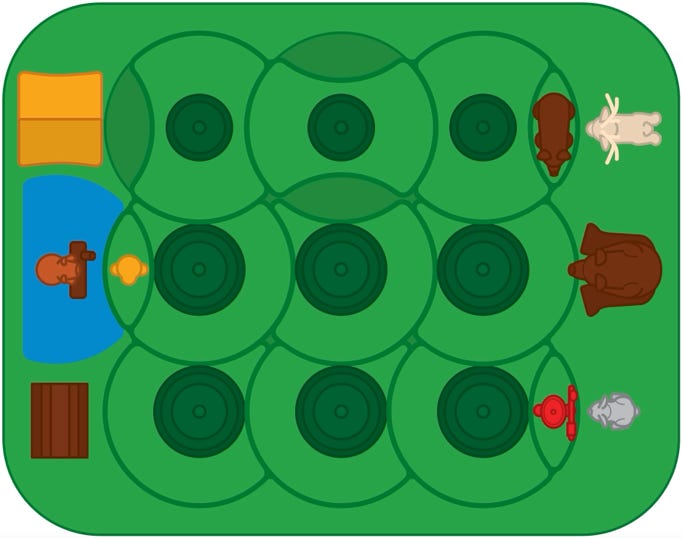
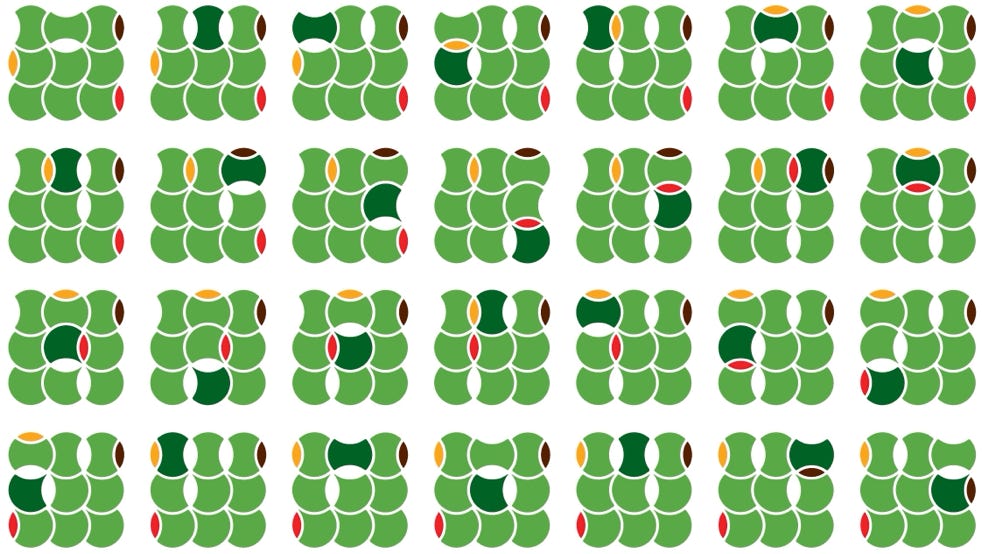
Example of a MASTER challenge and solution of Grizzly Gears. The dark green indicates which disk is rotated.
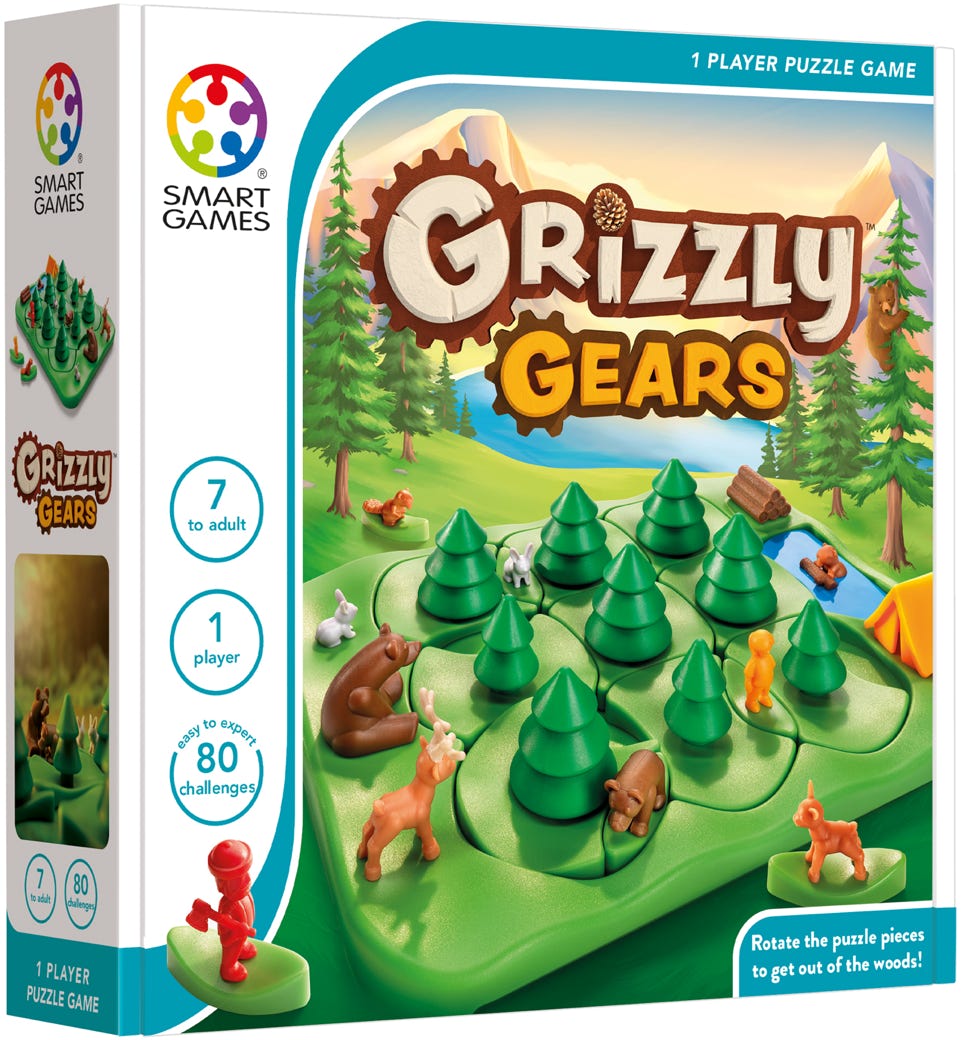
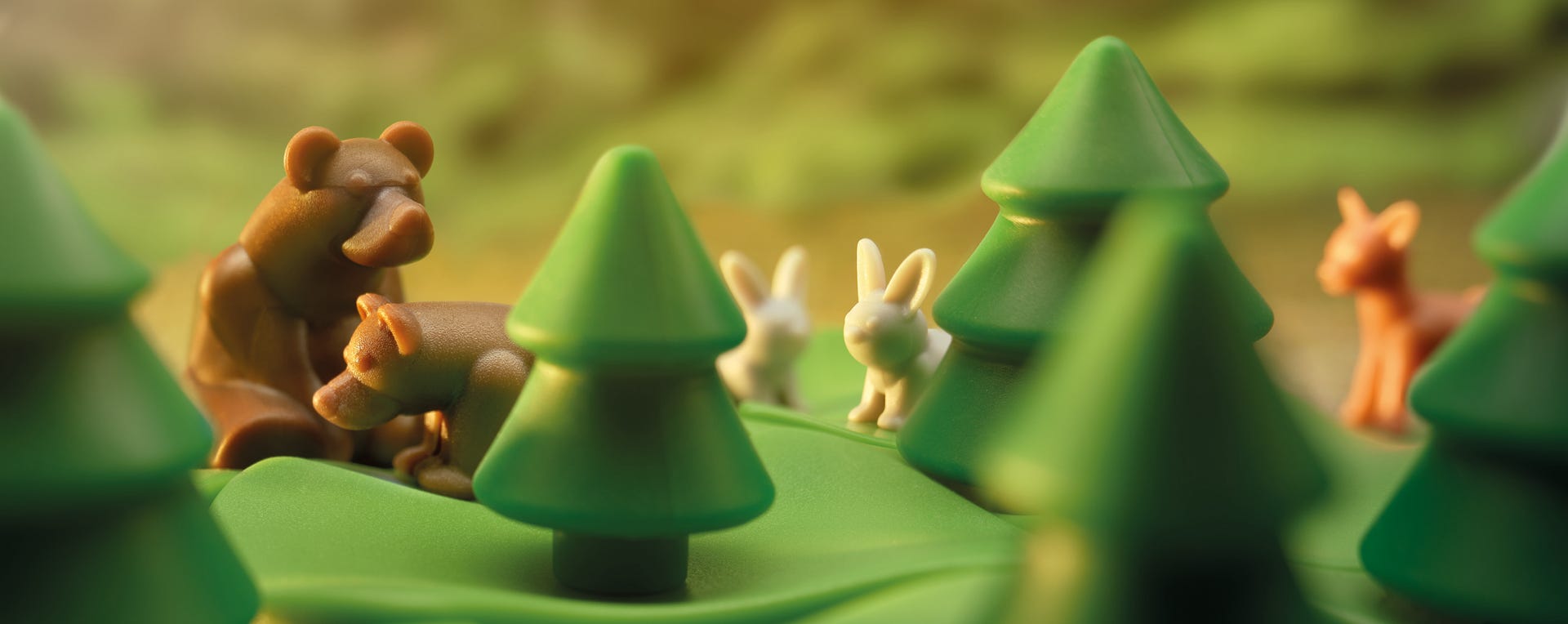
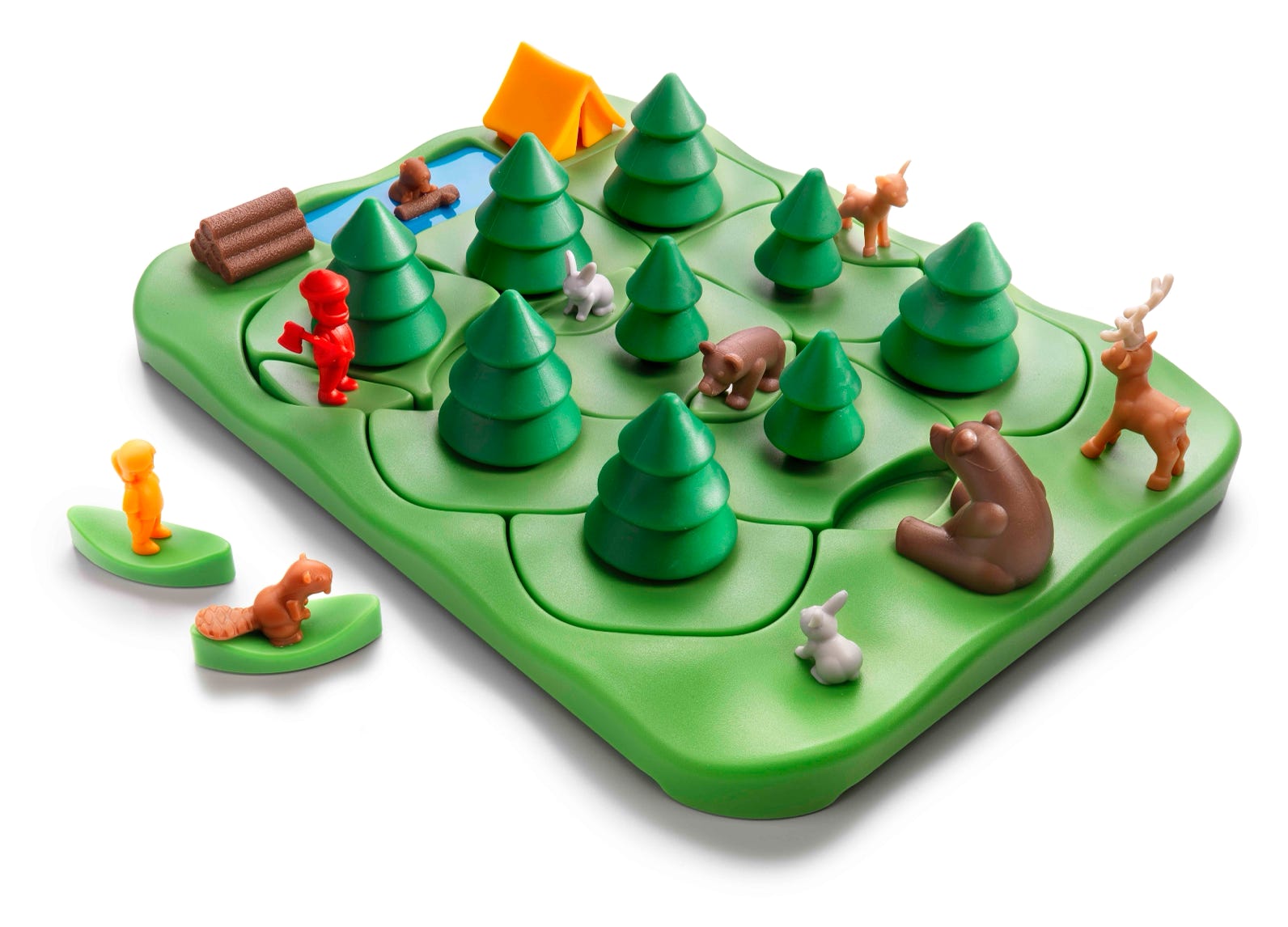
GAME RULES GRIZZLY GEARS
1) SETUP: Choose a challenge. Arrange the 9 circular pieces with trees on the game board as indicated in the challenge. Each piece must be placed in the indicated position AND orientation!
Place the "loose" human and/or animal characters in the indicated openings between the circular puzzle pieces. In most challenges you only have to place a few characters. Put those that are not shown in the challenge aside, you won't need them for the selected challenge.
2) PLAY: The object of Grizzly Gears is to move each character to its end position. Characters move by rotating the tree pieces.
A) The end positions are the places directly in front of the fixed characters and objects on the left and right border of the game board:
- the girl goes to her camping tent
- the beaver goes to the other beaver in the water
- the lumberjack goes to the pile of wood
- the child deer goes to the father deer
- Little Bear goes to Mother Bear
- the rabbit goes to his brother rabbit
B) Hold the trees in the middle and twist clockwise or counter-clockwise to rotate the puzzle pieces:
- Often puzzle pieces are blocked by other puzzle pieces that need to be rotated first.
- You are never allowed to lift up puzzle pieces or characters.
- Don’t push on the trees when you rotate them. The harder you push, the harder it is becomes to rotate them.
C) "Bear" in mind one important rule: Loose characters should NEVER end up directly in front of Mother Bear! In case they do, the puzzle piece will be blocked... and you'll have to start over. The exception is of course Little Bear. He must end up in front of his mother. But be aware not to move him too soon to his end position because if he gets blocked he might make the movement of other pieces impossible.
3) SOLUTION: You have found a solution when all loose characters shown in the challenge are in their end position at the same time. The shortest solution is shown at the end of the challenge booklet.
Website ©2022 Raf Peeters
Products and images: © Smart
